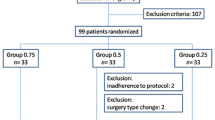Abstract
Background
There is no clinical study which has evaluated real effectiveness of ropivacaine when it is used in a subacromial pump in addition to its bolus injection in a mixture of agents. The aim of the study is to evaluate pain relieving effect of ropivacaine infusion by a pain pump after arthroscopic shoulder surgery.
Method
Thirty-six patients were randomly divided into three groups. Arthroscopic subacromial surgery was performed under general anesthesia. A subacromial catheter was placed in groups 1 and 2 patients. At the end of the operation, 15 ml of 0.5 % ropivacaine, 15 mg of ketolorac, and 4 mg morphine sulfate mixture was applied to all patients into the subacromial space. In addition to that, group 1 patients were applied with 0.5 % ropivacaine running through a pain pump at 4 cm3/h. Group 2 patients only received 100 cm3 saline (placebo) through the same pain pump, which was also running at 4 cm3/h. No additional intervention except subacromial mixture application was performed in group 3. Pain levels were evaluated by using the visual analogue scale.
Results
Twelve male and 19 female patients were included in this study. During the first postoperative hour, there was no difference between the groups in terms of pain scores. During the ongoing 24-h period, group 2 patients suffered less pain and had less analgesic need compared with the other two groups (p < 0.05). However, in the same day, there was no significant difference in pain scores and analgesic consumption between groups 1 and 3 (p > 0.05).
Conclusion
In terms of pain relief, the mixture of morphine, ropivacaine, and ketolorac was found to be as effective as the 24-h pump infusion of ropivacaine following arthroscopic rotator cuff repair. It was observed that placebo-given patients suffered less pain because saline increased the long-term effect of ropivacaine. So if an appropriate analgesic agent is applied to the subacromial space, there is no need for a pump infusion postoperatively.


Similar content being viewed by others
References
Cho NS, Ha JH, Rhee YG (2007) Patient-controlled analgesia after arthroscopic rotator cuff repair: subacromial catheter versus intravenous injection. Am J Sports Med 35:75–79
Coghlan JA, Forbes A, McKenzie D, Bell SN, Buchbinder R (2009) Efficacy of subacromial ropivacaine infusion for rotator cuff surgery. J Bone Joint Surg Am 91(7):1558–1567
Souter AJ, Fredman B, White PF (1994) Controversies in the perioperative use of nonsterodial antiinflammatory drugs. Anesth Analg 79:1178–1190
Borgeat A, Ekatodramis G, Kalberer F, Benz C (2001) Acute and nonacute complications associated with interscalene block and shoulder surgery: a prospective study. Anesthesiology 95:875–880
Winkler T, Suda AJ, Dumitrescu RV, Pinggera O, Weber G, Loho G, Schneider B, Wurnig C (2009) Interscalene versus subacromial continuous infusion of ropivacaine after arthroscopic acromioplasty. J Shoulder Elbow Surg 18(4):566–572
Järvelä T, Järvelä S (2008) Long-term effect of the use of a pain pump after arthroscopic subacromial decompression. Arthroscopy 24(12):1402–1406
Fu P, Wu Y, Wu H, Li X, Qian Q, Zhu Y (2009) Efficacy of intra-articular cocktail analgesic injection in total knee arthroplasty—a randomized controlled trial. Knee 16(4):280–284
Harvey GP, Chelly JE, AlSamsam T, Coupe K (2004) Patient-controlled ropivacaine analgesia after arthroscopic subacromial decompression. Arthroscopy 20(5):451–455
Doss NW, Splain SH, Crimi T, Michael R, Abadir AR, Gintautas J (2001) Intra-articular morphine, ropivacaine, and morphine/ropivacaine for pain control after arthroscopy: preliminary observation. Proc West Pharmacol Soc 44:195–196
Klein SM, Nielsen KC, Martin A, White W, Warner DS, Steele SM, Speer KP, Greengrass RA (2001) Interscalene brachial plexus block with continuous intraarticular infusion of ropivacaine. Anesth Analg 93(3):601–605
Park JY, Lee GW, Kim Y, Moon J (2002) The efficacy of continuous intrabursal infusion with morphine and bupivacaine for postoperative analgesia after subacromial arthroscopy. Reg Anesth Pain Med 27(2):145–149
Chelly JE, AlSamsam T, Coupe K (2004) Patient-controlled ropivacaine analgesia after arthroscopic subacromial decompression. Arthroscopy 20(5):451–455
Coghlan JA, Forbes A, Bell SN, Buchbinder R (2008) Efficacy and safety of a subacromial continuous ropivacaine infusion for postoperative pain management following arthroscopic rotator cuff surgery. BMC Musculoskelet Disord 22:9–56
Quick DC, Guanche CA (2003) Evaluation of an anesthetic pump for postoperative care after shoulder surgery. J Shoulder Elbow Surg 12:618–621
Brower MC, Johnson ME (2003) Adverse effects of local anesthetic infiltration on wound healing. Reg Anesth Pain Med 28:233–240
Brown SL, Morrison AE (2004) Local anesthetic infusion pump systems adverse events reported to the Food and Drug Administration. Anesthesiology 100(5):1305–1307
Abdulla S, Eckhardt R, Netter U, Abdulla W (2012) Randomized, double-blind, placebo-controlled study to assess the efficacy of non-opioid analgesics on pain following arthroscopic knee. Surg Pain Res Treat 2012:305821
Merivirta R, Aärimaa V, Aantaa R, Koivisto M, Leino K, Liukas A, Kuusniemi K (2013) Postoperative fentanyl patch versus subacromial bupivacaine infusion in arthroscopic shoulder surgery. Arthroscopy 29(7):1129–1134
Ackermann M, Maier S, Ing H, Bonnabry P (2007) Evaluation of the design and reliability of three elastomeric and one mechanical infusers. J Oncol Pharm Pract 13:77–84
Author information
Authors and Affiliations
Corresponding author
Rights and permissions
About this article
Cite this article
Saygi, B., Karaman, O., Konakci, M. et al. Comparison of analgesic methods by using ropivacaine after arthroscopic shoulder surgery. Eur Orthop Traumatol 5, 149–152 (2014). https://doi.org/10.1007/s12570-013-0217-z
Received:
Accepted:
Published:
Issue Date:
DOI: https://doi.org/10.1007/s12570-013-0217-z




